Financial Planning and Resource Management: WM Morrison Report
VerifiedAdded on 2020/01/15
|14
|3921
|178
Report
AI Summary
This report offers a comprehensive analysis of WM Morrison's financial management, covering various aspects such as sources of finance, financial planning, and budget analysis. It explores the implications of different financing sources like retained earnings, share issues, and bank loans, evaluating their associated costs and impacts on financial statements. The report delves into the importance of financial planning for determining funding requirements and optimizing resource utilization. It also examines the information needs of stakeholders like suppliers, investors, and government bodies. Furthermore, the report includes a cash budget analysis from January to June, highlighting the supermarket's financial performance. The analysis also covers the interpretation of financial statements using ratios and the assessment of project viability through investment appraisal techniques. This report serves as a practical case study on financial resource management within the context of a major supermarket chain.

MFRD
1
1
Paraphrase This Document
Need a fresh take? Get an instant paraphrase of this document with our AI Paraphraser
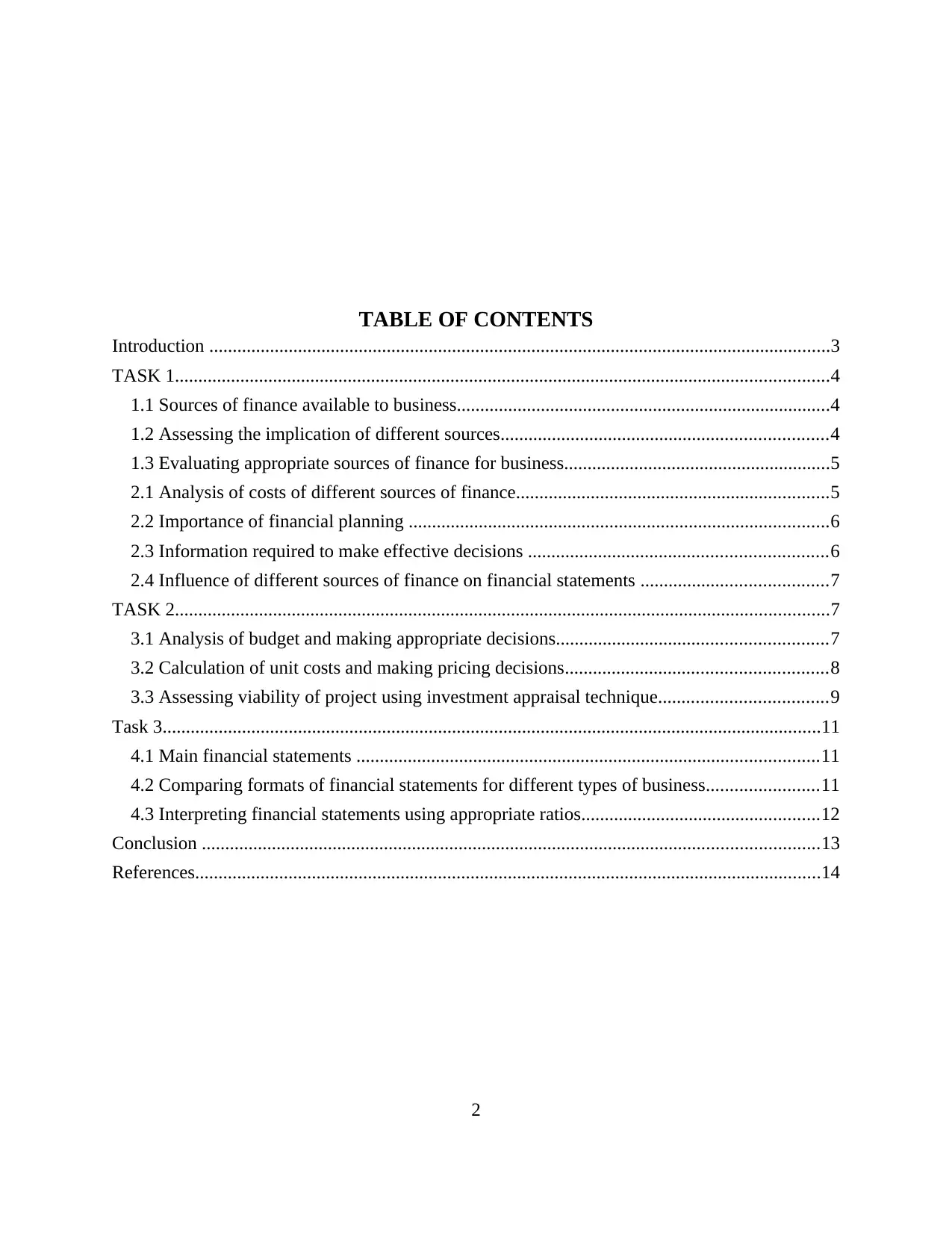
TABLE OF CONTENTS
Introduction .....................................................................................................................................3
TASK 1............................................................................................................................................4
1.1 Sources of finance available to business................................................................................4
1.2 Assessing the implication of different sources......................................................................4
1.3 Evaluating appropriate sources of finance for business.........................................................5
2.1 Analysis of costs of different sources of finance...................................................................5
2.2 Importance of financial planning ..........................................................................................6
2.3 Information required to make effective decisions ................................................................6
2.4 Influence of different sources of finance on financial statements ........................................7
TASK 2............................................................................................................................................7
3.1 Analysis of budget and making appropriate decisions..........................................................7
3.2 Calculation of unit costs and making pricing decisions........................................................8
3.3 Assessing viability of project using investment appraisal technique....................................9
Task 3.............................................................................................................................................11
4.1 Main financial statements ...................................................................................................11
4.2 Comparing formats of financial statements for different types of business........................11
4.3 Interpreting financial statements using appropriate ratios...................................................12
Conclusion ....................................................................................................................................13
References......................................................................................................................................14
2
Introduction .....................................................................................................................................3
TASK 1............................................................................................................................................4
1.1 Sources of finance available to business................................................................................4
1.2 Assessing the implication of different sources......................................................................4
1.3 Evaluating appropriate sources of finance for business.........................................................5
2.1 Analysis of costs of different sources of finance...................................................................5
2.2 Importance of financial planning ..........................................................................................6
2.3 Information required to make effective decisions ................................................................6
2.4 Influence of different sources of finance on financial statements ........................................7
TASK 2............................................................................................................................................7
3.1 Analysis of budget and making appropriate decisions..........................................................7
3.2 Calculation of unit costs and making pricing decisions........................................................8
3.3 Assessing viability of project using investment appraisal technique....................................9
Task 3.............................................................................................................................................11
4.1 Main financial statements ...................................................................................................11
4.2 Comparing formats of financial statements for different types of business........................11
4.3 Interpreting financial statements using appropriate ratios...................................................12
Conclusion ....................................................................................................................................13
References......................................................................................................................................14
2

3
⊘ This is a preview!⊘
Do you want full access?
Subscribe today to unlock all pages.

Trusted by 1+ million students worldwide
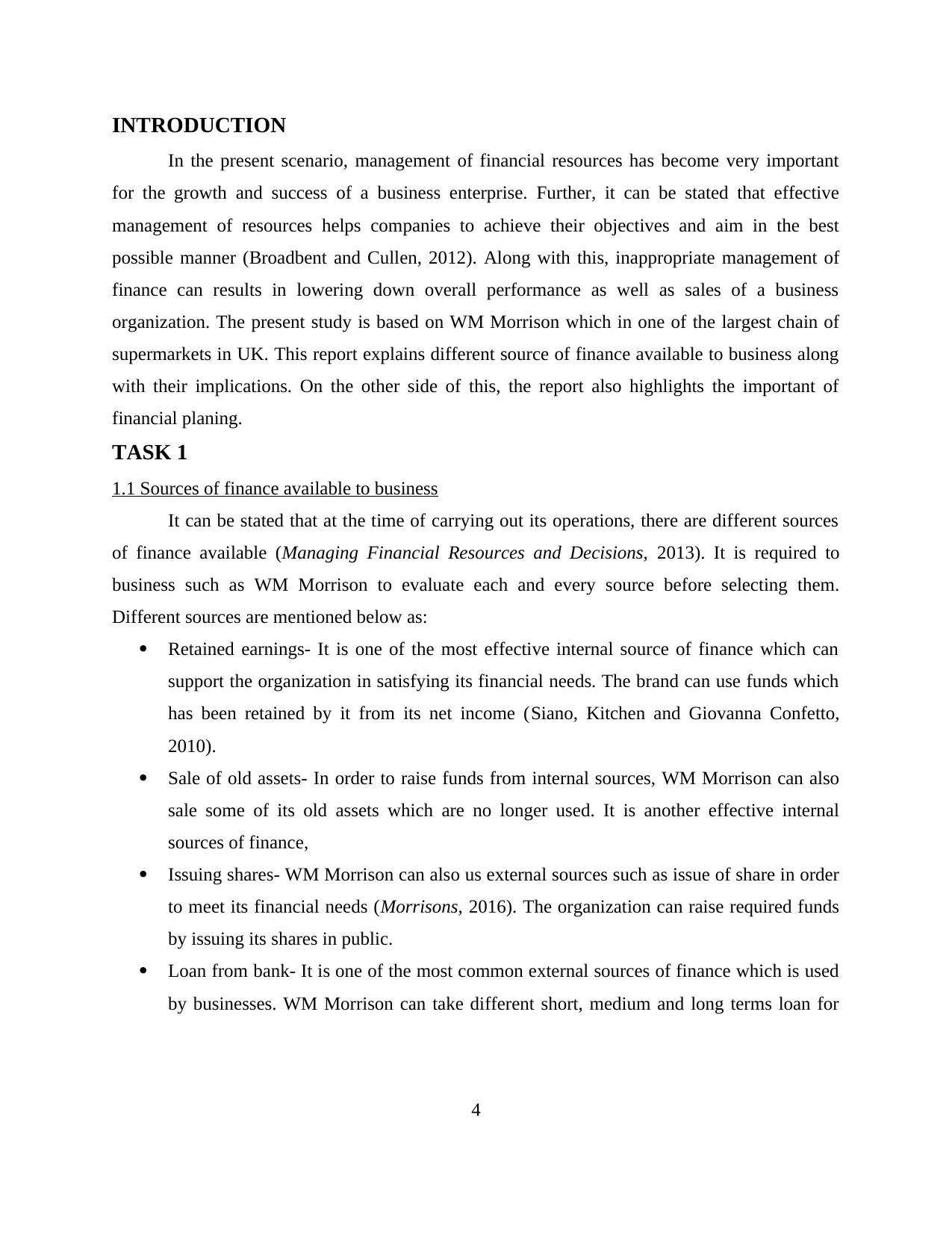
INTRODUCTION
In the present scenario, management of financial resources has become very important
for the growth and success of a business enterprise. Further, it can be stated that effective
management of resources helps companies to achieve their objectives and aim in the best
possible manner (Broadbent and Cullen, 2012). Along with this, inappropriate management of
finance can results in lowering down overall performance as well as sales of a business
organization. The present study is based on WM Morrison which in one of the largest chain of
supermarkets in UK. This report explains different source of finance available to business along
with their implications. On the other side of this, the report also highlights the important of
financial planing.
TASK 1
1.1 Sources of finance available to business
It can be stated that at the time of carrying out its operations, there are different sources
of finance available (Managing Financial Resources and Decisions, 2013). It is required to
business such as WM Morrison to evaluate each and every source before selecting them.
Different sources are mentioned below as:
Retained earnings- It is one of the most effective internal source of finance which can
support the organization in satisfying its financial needs. The brand can use funds which
has been retained by it from its net income (Siano, Kitchen and Giovanna Confetto,
2010).
Sale of old assets- In order to raise funds from internal sources, WM Morrison can also
sale some of its old assets which are no longer used. It is another effective internal
sources of finance,
Issuing shares- WM Morrison can also us external sources such as issue of share in order
to meet its financial needs (Morrisons, 2016). The organization can raise required funds
by issuing its shares in public.
Loan from bank- It is one of the most common external sources of finance which is used
by businesses. WM Morrison can take different short, medium and long terms loan for
4
In the present scenario, management of financial resources has become very important
for the growth and success of a business enterprise. Further, it can be stated that effective
management of resources helps companies to achieve their objectives and aim in the best
possible manner (Broadbent and Cullen, 2012). Along with this, inappropriate management of
finance can results in lowering down overall performance as well as sales of a business
organization. The present study is based on WM Morrison which in one of the largest chain of
supermarkets in UK. This report explains different source of finance available to business along
with their implications. On the other side of this, the report also highlights the important of
financial planing.
TASK 1
1.1 Sources of finance available to business
It can be stated that at the time of carrying out its operations, there are different sources
of finance available (Managing Financial Resources and Decisions, 2013). It is required to
business such as WM Morrison to evaluate each and every source before selecting them.
Different sources are mentioned below as:
Retained earnings- It is one of the most effective internal source of finance which can
support the organization in satisfying its financial needs. The brand can use funds which
has been retained by it from its net income (Siano, Kitchen and Giovanna Confetto,
2010).
Sale of old assets- In order to raise funds from internal sources, WM Morrison can also
sale some of its old assets which are no longer used. It is another effective internal
sources of finance,
Issuing shares- WM Morrison can also us external sources such as issue of share in order
to meet its financial needs (Morrisons, 2016). The organization can raise required funds
by issuing its shares in public.
Loan from bank- It is one of the most common external sources of finance which is used
by businesses. WM Morrison can take different short, medium and long terms loan for
4
Paraphrase This Document
Need a fresh take? Get an instant paraphrase of this document with our AI Paraphraser
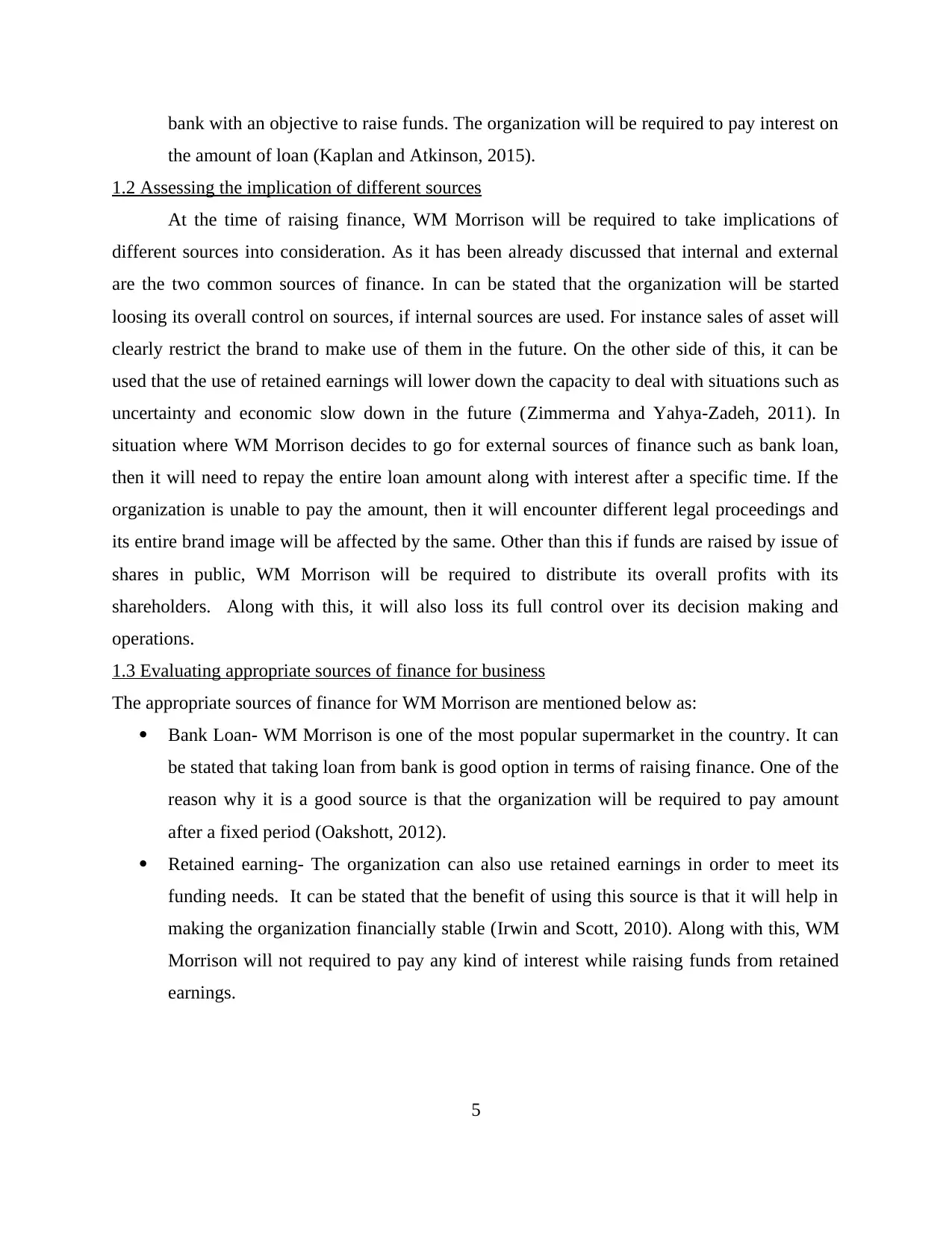
bank with an objective to raise funds. The organization will be required to pay interest on
the amount of loan (Kaplan and Atkinson, 2015).
1.2 Assessing the implication of different sources
At the time of raising finance, WM Morrison will be required to take implications of
different sources into consideration. As it has been already discussed that internal and external
are the two common sources of finance. In can be stated that the organization will be started
loosing its overall control on sources, if internal sources are used. For instance sales of asset will
clearly restrict the brand to make use of them in the future. On the other side of this, it can be
used that the use of retained earnings will lower down the capacity to deal with situations such as
uncertainty and economic slow down in the future (Zimmerma and Yahya-Zadeh, 2011). In
situation where WM Morrison decides to go for external sources of finance such as bank loan,
then it will need to repay the entire loan amount along with interest after a specific time. If the
organization is unable to pay the amount, then it will encounter different legal proceedings and
its entire brand image will be affected by the same. Other than this if funds are raised by issue of
shares in public, WM Morrison will be required to distribute its overall profits with its
shareholders. Along with this, it will also loss its full control over its decision making and
operations.
1.3 Evaluating appropriate sources of finance for business
The appropriate sources of finance for WM Morrison are mentioned below as:
Bank Loan- WM Morrison is one of the most popular supermarket in the country. It can
be stated that taking loan from bank is good option in terms of raising finance. One of the
reason why it is a good source is that the organization will be required to pay amount
after a fixed period (Oakshott, 2012).
Retained earning- The organization can also use retained earnings in order to meet its
funding needs. It can be stated that the benefit of using this source is that it will help in
making the organization financially stable (Irwin and Scott, 2010). Along with this, WM
Morrison will not required to pay any kind of interest while raising funds from retained
earnings.
5
the amount of loan (Kaplan and Atkinson, 2015).
1.2 Assessing the implication of different sources
At the time of raising finance, WM Morrison will be required to take implications of
different sources into consideration. As it has been already discussed that internal and external
are the two common sources of finance. In can be stated that the organization will be started
loosing its overall control on sources, if internal sources are used. For instance sales of asset will
clearly restrict the brand to make use of them in the future. On the other side of this, it can be
used that the use of retained earnings will lower down the capacity to deal with situations such as
uncertainty and economic slow down in the future (Zimmerma and Yahya-Zadeh, 2011). In
situation where WM Morrison decides to go for external sources of finance such as bank loan,
then it will need to repay the entire loan amount along with interest after a specific time. If the
organization is unable to pay the amount, then it will encounter different legal proceedings and
its entire brand image will be affected by the same. Other than this if funds are raised by issue of
shares in public, WM Morrison will be required to distribute its overall profits with its
shareholders. Along with this, it will also loss its full control over its decision making and
operations.
1.3 Evaluating appropriate sources of finance for business
The appropriate sources of finance for WM Morrison are mentioned below as:
Bank Loan- WM Morrison is one of the most popular supermarket in the country. It can
be stated that taking loan from bank is good option in terms of raising finance. One of the
reason why it is a good source is that the organization will be required to pay amount
after a fixed period (Oakshott, 2012).
Retained earning- The organization can also use retained earnings in order to meet its
funding needs. It can be stated that the benefit of using this source is that it will help in
making the organization financially stable (Irwin and Scott, 2010). Along with this, WM
Morrison will not required to pay any kind of interest while raising funds from retained
earnings.
5
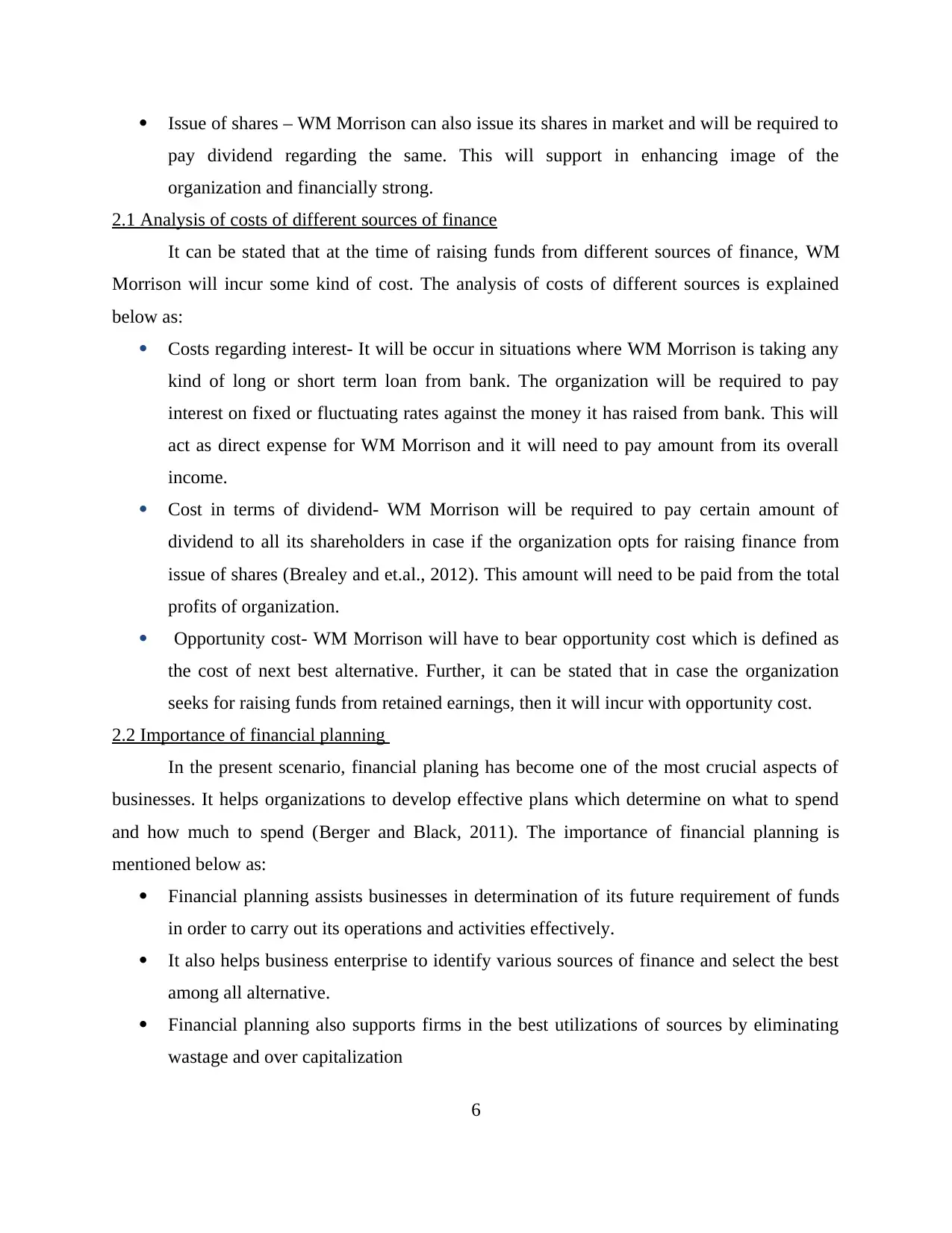
Issue of shares – WM Morrison can also issue its shares in market and will be required to
pay dividend regarding the same. This will support in enhancing image of the
organization and financially strong.
2.1 Analysis of costs of different sources of finance
It can be stated that at the time of raising funds from different sources of finance, WM
Morrison will incur some kind of cost. The analysis of costs of different sources is explained
below as:
Costs regarding interest- It will be occur in situations where WM Morrison is taking any
kind of long or short term loan from bank. The organization will be required to pay
interest on fixed or fluctuating rates against the money it has raised from bank. This will
act as direct expense for WM Morrison and it will need to pay amount from its overall
income.
Cost in terms of dividend- WM Morrison will be required to pay certain amount of
dividend to all its shareholders in case if the organization opts for raising finance from
issue of shares (Brealey and et.al., 2012). This amount will need to be paid from the total
profits of organization.
Opportunity cost- WM Morrison will have to bear opportunity cost which is defined as
the cost of next best alternative. Further, it can be stated that in case the organization
seeks for raising funds from retained earnings, then it will incur with opportunity cost.
2.2 Importance of financial planning
In the present scenario, financial planing has become one of the most crucial aspects of
businesses. It helps organizations to develop effective plans which determine on what to spend
and how much to spend (Berger and Black, 2011). The importance of financial planning is
mentioned below as:
Financial planning assists businesses in determination of its future requirement of funds
in order to carry out its operations and activities effectively.
It also helps business enterprise to identify various sources of finance and select the best
among all alternative.
Financial planning also supports firms in the best utilizations of sources by eliminating
wastage and over capitalization
6
pay dividend regarding the same. This will support in enhancing image of the
organization and financially strong.
2.1 Analysis of costs of different sources of finance
It can be stated that at the time of raising funds from different sources of finance, WM
Morrison will incur some kind of cost. The analysis of costs of different sources is explained
below as:
Costs regarding interest- It will be occur in situations where WM Morrison is taking any
kind of long or short term loan from bank. The organization will be required to pay
interest on fixed or fluctuating rates against the money it has raised from bank. This will
act as direct expense for WM Morrison and it will need to pay amount from its overall
income.
Cost in terms of dividend- WM Morrison will be required to pay certain amount of
dividend to all its shareholders in case if the organization opts for raising finance from
issue of shares (Brealey and et.al., 2012). This amount will need to be paid from the total
profits of organization.
Opportunity cost- WM Morrison will have to bear opportunity cost which is defined as
the cost of next best alternative. Further, it can be stated that in case the organization
seeks for raising funds from retained earnings, then it will incur with opportunity cost.
2.2 Importance of financial planning
In the present scenario, financial planing has become one of the most crucial aspects of
businesses. It helps organizations to develop effective plans which determine on what to spend
and how much to spend (Berger and Black, 2011). The importance of financial planning is
mentioned below as:
Financial planning assists businesses in determination of its future requirement of funds
in order to carry out its operations and activities effectively.
It also helps business enterprise to identify various sources of finance and select the best
among all alternative.
Financial planning also supports firms in the best utilizations of sources by eliminating
wastage and over capitalization
6
⊘ This is a preview!⊘
Do you want full access?
Subscribe today to unlock all pages.

Trusted by 1+ million students worldwide
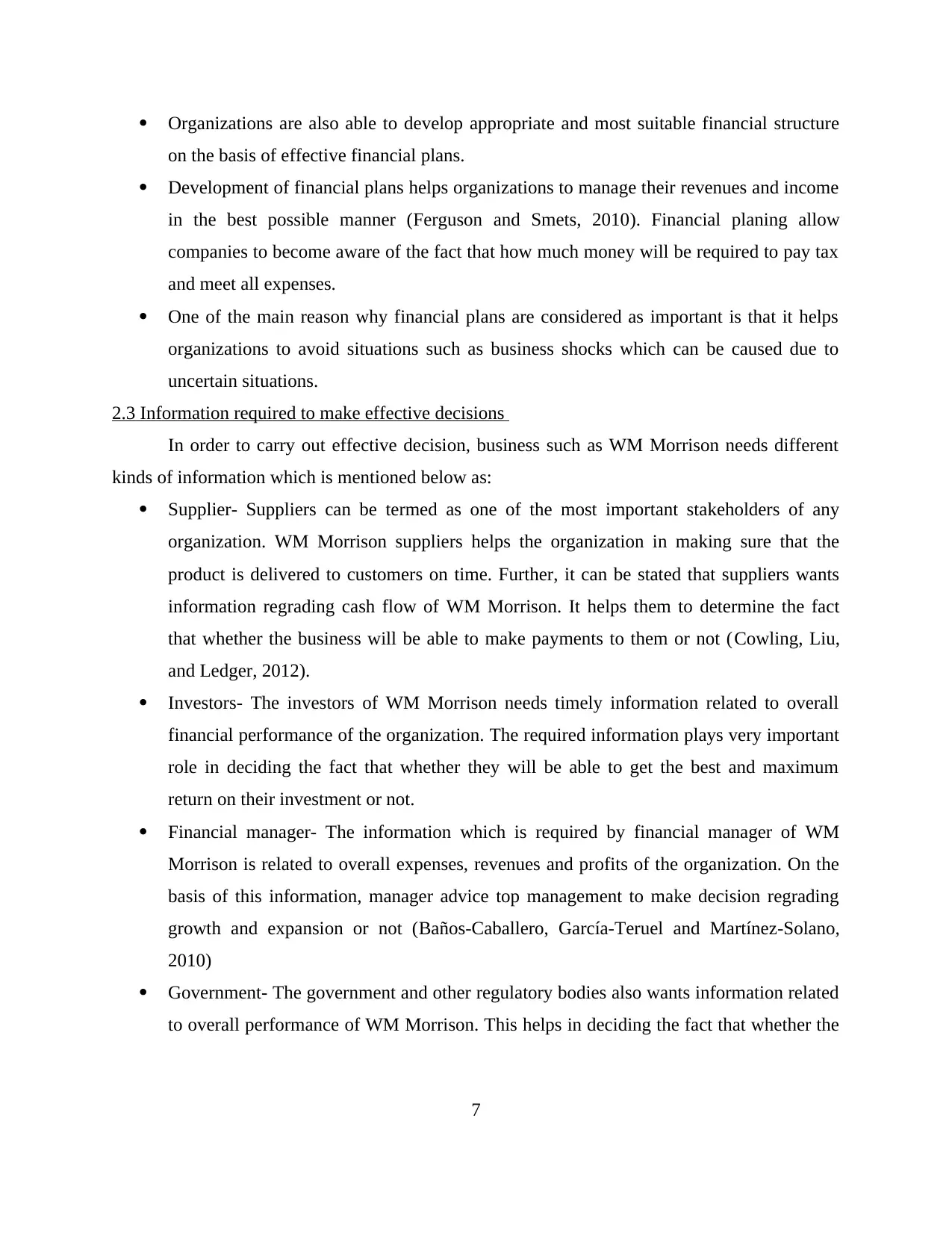
Organizations are also able to develop appropriate and most suitable financial structure
on the basis of effective financial plans.
Development of financial plans helps organizations to manage their revenues and income
in the best possible manner (Ferguson and Smets, 2010). Financial planing allow
companies to become aware of the fact that how much money will be required to pay tax
and meet all expenses.
One of the main reason why financial plans are considered as important is that it helps
organizations to avoid situations such as business shocks which can be caused due to
uncertain situations.
2.3 Information required to make effective decisions
In order to carry out effective decision, business such as WM Morrison needs different
kinds of information which is mentioned below as:
Supplier- Suppliers can be termed as one of the most important stakeholders of any
organization. WM Morrison suppliers helps the organization in making sure that the
product is delivered to customers on time. Further, it can be stated that suppliers wants
information regrading cash flow of WM Morrison. It helps them to determine the fact
that whether the business will be able to make payments to them or not (Cowling, Liu,
and Ledger, 2012).
Investors- The investors of WM Morrison needs timely information related to overall
financial performance of the organization. The required information plays very important
role in deciding the fact that whether they will be able to get the best and maximum
return on their investment or not.
Financial manager- The information which is required by financial manager of WM
Morrison is related to overall expenses, revenues and profits of the organization. On the
basis of this information, manager advice top management to make decision regrading
growth and expansion or not (Baños‐Caballero, García‐Teruel and Martínez‐Solano,
2010)
Government- The government and other regulatory bodies also wants information related
to overall performance of WM Morrison. This helps in deciding the fact that whether the
7
on the basis of effective financial plans.
Development of financial plans helps organizations to manage their revenues and income
in the best possible manner (Ferguson and Smets, 2010). Financial planing allow
companies to become aware of the fact that how much money will be required to pay tax
and meet all expenses.
One of the main reason why financial plans are considered as important is that it helps
organizations to avoid situations such as business shocks which can be caused due to
uncertain situations.
2.3 Information required to make effective decisions
In order to carry out effective decision, business such as WM Morrison needs different
kinds of information which is mentioned below as:
Supplier- Suppliers can be termed as one of the most important stakeholders of any
organization. WM Morrison suppliers helps the organization in making sure that the
product is delivered to customers on time. Further, it can be stated that suppliers wants
information regrading cash flow of WM Morrison. It helps them to determine the fact
that whether the business will be able to make payments to them or not (Cowling, Liu,
and Ledger, 2012).
Investors- The investors of WM Morrison needs timely information related to overall
financial performance of the organization. The required information plays very important
role in deciding the fact that whether they will be able to get the best and maximum
return on their investment or not.
Financial manager- The information which is required by financial manager of WM
Morrison is related to overall expenses, revenues and profits of the organization. On the
basis of this information, manager advice top management to make decision regrading
growth and expansion or not (Baños‐Caballero, García‐Teruel and Martínez‐Solano,
2010)
Government- The government and other regulatory bodies also wants information related
to overall performance of WM Morrison. This helps in deciding the fact that whether the
7
Paraphrase This Document
Need a fresh take? Get an instant paraphrase of this document with our AI Paraphraser
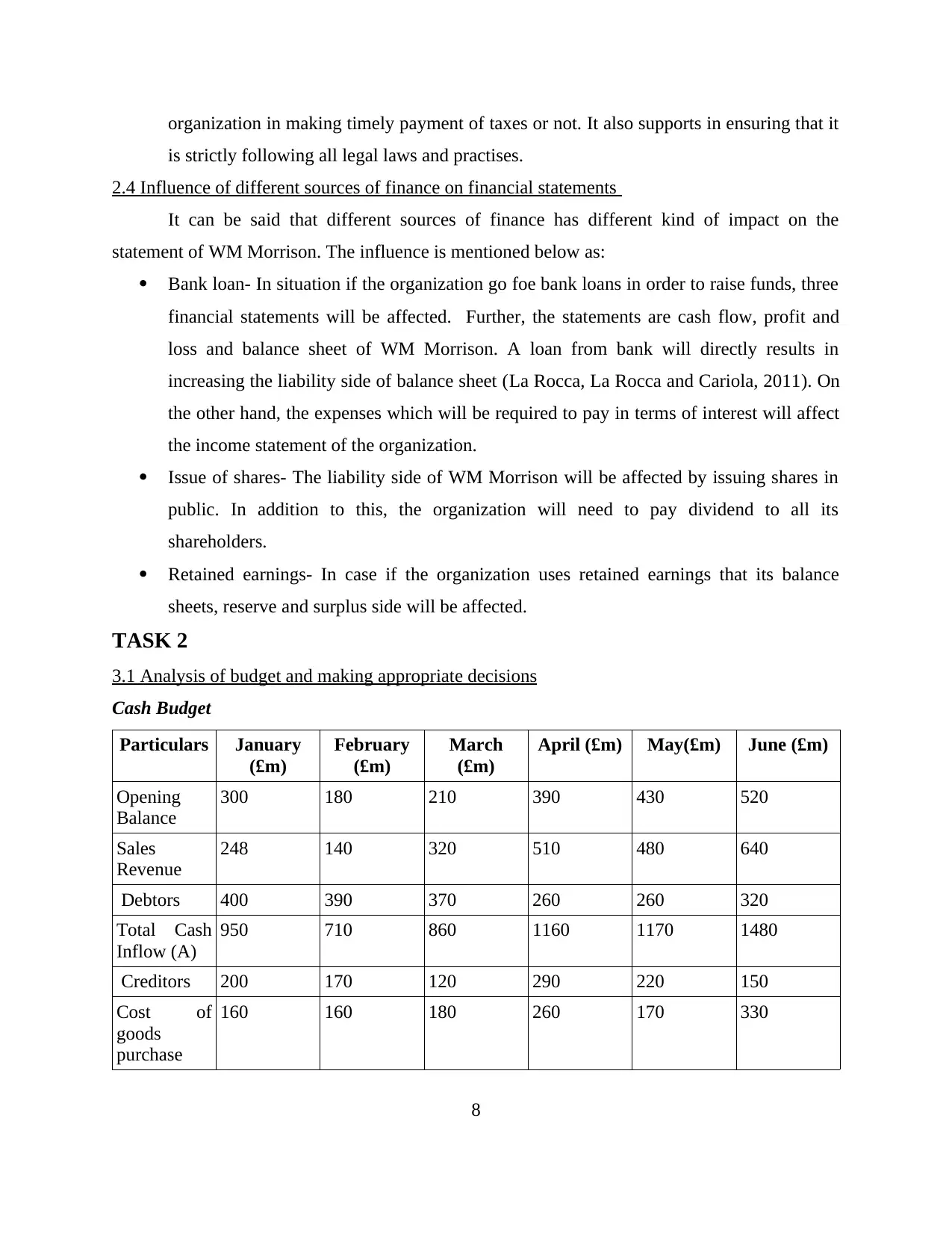
organization in making timely payment of taxes or not. It also supports in ensuring that it
is strictly following all legal laws and practises.
2.4 Influence of different sources of finance on financial statements
It can be said that different sources of finance has different kind of impact on the
statement of WM Morrison. The influence is mentioned below as:
Bank loan- In situation if the organization go foe bank loans in order to raise funds, three
financial statements will be affected. Further, the statements are cash flow, profit and
loss and balance sheet of WM Morrison. A loan from bank will directly results in
increasing the liability side of balance sheet (La Rocca, La Rocca and Cariola, 2011). On
the other hand, the expenses which will be required to pay in terms of interest will affect
the income statement of the organization.
Issue of shares- The liability side of WM Morrison will be affected by issuing shares in
public. In addition to this, the organization will need to pay dividend to all its
shareholders.
Retained earnings- In case if the organization uses retained earnings that its balance
sheets, reserve and surplus side will be affected.
TASK 2
3.1 Analysis of budget and making appropriate decisions
Cash Budget
Particulars January
(£m)
February
(£m)
March
(£m)
April (£m) May(£m) June (£m)
Opening
Balance
300 180 210 390 430 520
Sales
Revenue
248 140 320 510 480 640
Debtors 400 390 370 260 260 320
Total Cash
Inflow (A)
950 710 860 1160 1170 1480
Creditors 200 170 120 290 220 150
Cost of
goods
purchase
160 160 180 260 170 330
8
is strictly following all legal laws and practises.
2.4 Influence of different sources of finance on financial statements
It can be said that different sources of finance has different kind of impact on the
statement of WM Morrison. The influence is mentioned below as:
Bank loan- In situation if the organization go foe bank loans in order to raise funds, three
financial statements will be affected. Further, the statements are cash flow, profit and
loss and balance sheet of WM Morrison. A loan from bank will directly results in
increasing the liability side of balance sheet (La Rocca, La Rocca and Cariola, 2011). On
the other hand, the expenses which will be required to pay in terms of interest will affect
the income statement of the organization.
Issue of shares- The liability side of WM Morrison will be affected by issuing shares in
public. In addition to this, the organization will need to pay dividend to all its
shareholders.
Retained earnings- In case if the organization uses retained earnings that its balance
sheets, reserve and surplus side will be affected.
TASK 2
3.1 Analysis of budget and making appropriate decisions
Cash Budget
Particulars January
(£m)
February
(£m)
March
(£m)
April (£m) May(£m) June (£m)
Opening
Balance
300 180 210 390 430 520
Sales
Revenue
248 140 320 510 480 640
Debtors 400 390 370 260 260 320
Total Cash
Inflow (A)
950 710 860 1160 1170 1480
Creditors 200 170 120 290 220 150
Cost of
goods
purchase
160 160 180 260 170 330
8
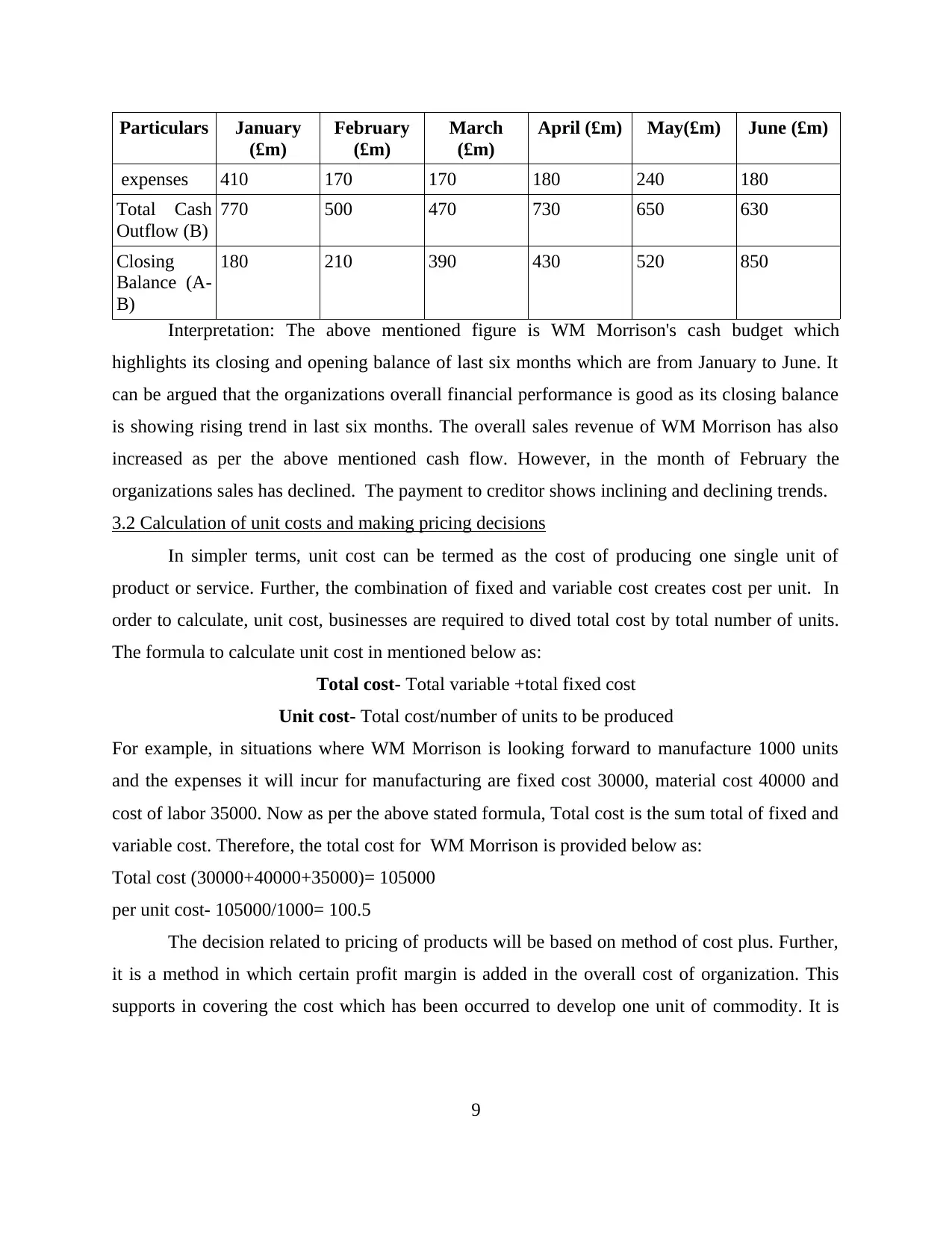
Particulars January
(£m)
February
(£m)
March
(£m)
April (£m) May(£m) June (£m)
expenses 410 170 170 180 240 180
Total Cash
Outflow (B)
770 500 470 730 650 630
Closing
Balance (A-
B)
180 210 390 430 520 850
Interpretation: The above mentioned figure is WM Morrison's cash budget which
highlights its closing and opening balance of last six months which are from January to June. It
can be argued that the organizations overall financial performance is good as its closing balance
is showing rising trend in last six months. The overall sales revenue of WM Morrison has also
increased as per the above mentioned cash flow. However, in the month of February the
organizations sales has declined. The payment to creditor shows inclining and declining trends.
3.2 Calculation of unit costs and making pricing decisions
In simpler terms, unit cost can be termed as the cost of producing one single unit of
product or service. Further, the combination of fixed and variable cost creates cost per unit. In
order to calculate, unit cost, businesses are required to dived total cost by total number of units.
The formula to calculate unit cost in mentioned below as:
Total cost- Total variable +total fixed cost
Unit cost- Total cost/number of units to be produced
For example, in situations where WM Morrison is looking forward to manufacture 1000 units
and the expenses it will incur for manufacturing are fixed cost 30000, material cost 40000 and
cost of labor 35000. Now as per the above stated formula, Total cost is the sum total of fixed and
variable cost. Therefore, the total cost for WM Morrison is provided below as:
Total cost (30000+40000+35000)= 105000
per unit cost- 105000/1000= 100.5
The decision related to pricing of products will be based on method of cost plus. Further,
it is a method in which certain profit margin is added in the overall cost of organization. This
supports in covering the cost which has been occurred to develop one unit of commodity. It is
9
(£m)
February
(£m)
March
(£m)
April (£m) May(£m) June (£m)
expenses 410 170 170 180 240 180
Total Cash
Outflow (B)
770 500 470 730 650 630
Closing
Balance (A-
B)
180 210 390 430 520 850
Interpretation: The above mentioned figure is WM Morrison's cash budget which
highlights its closing and opening balance of last six months which are from January to June. It
can be argued that the organizations overall financial performance is good as its closing balance
is showing rising trend in last six months. The overall sales revenue of WM Morrison has also
increased as per the above mentioned cash flow. However, in the month of February the
organizations sales has declined. The payment to creditor shows inclining and declining trends.
3.2 Calculation of unit costs and making pricing decisions
In simpler terms, unit cost can be termed as the cost of producing one single unit of
product or service. Further, the combination of fixed and variable cost creates cost per unit. In
order to calculate, unit cost, businesses are required to dived total cost by total number of units.
The formula to calculate unit cost in mentioned below as:
Total cost- Total variable +total fixed cost
Unit cost- Total cost/number of units to be produced
For example, in situations where WM Morrison is looking forward to manufacture 1000 units
and the expenses it will incur for manufacturing are fixed cost 30000, material cost 40000 and
cost of labor 35000. Now as per the above stated formula, Total cost is the sum total of fixed and
variable cost. Therefore, the total cost for WM Morrison is provided below as:
Total cost (30000+40000+35000)= 105000
per unit cost- 105000/1000= 100.5
The decision related to pricing of products will be based on method of cost plus. Further,
it is a method in which certain profit margin is added in the overall cost of organization. This
supports in covering the cost which has been occurred to develop one unit of commodity. It is
9
⊘ This is a preview!⊘
Do you want full access?
Subscribe today to unlock all pages.

Trusted by 1+ million students worldwide
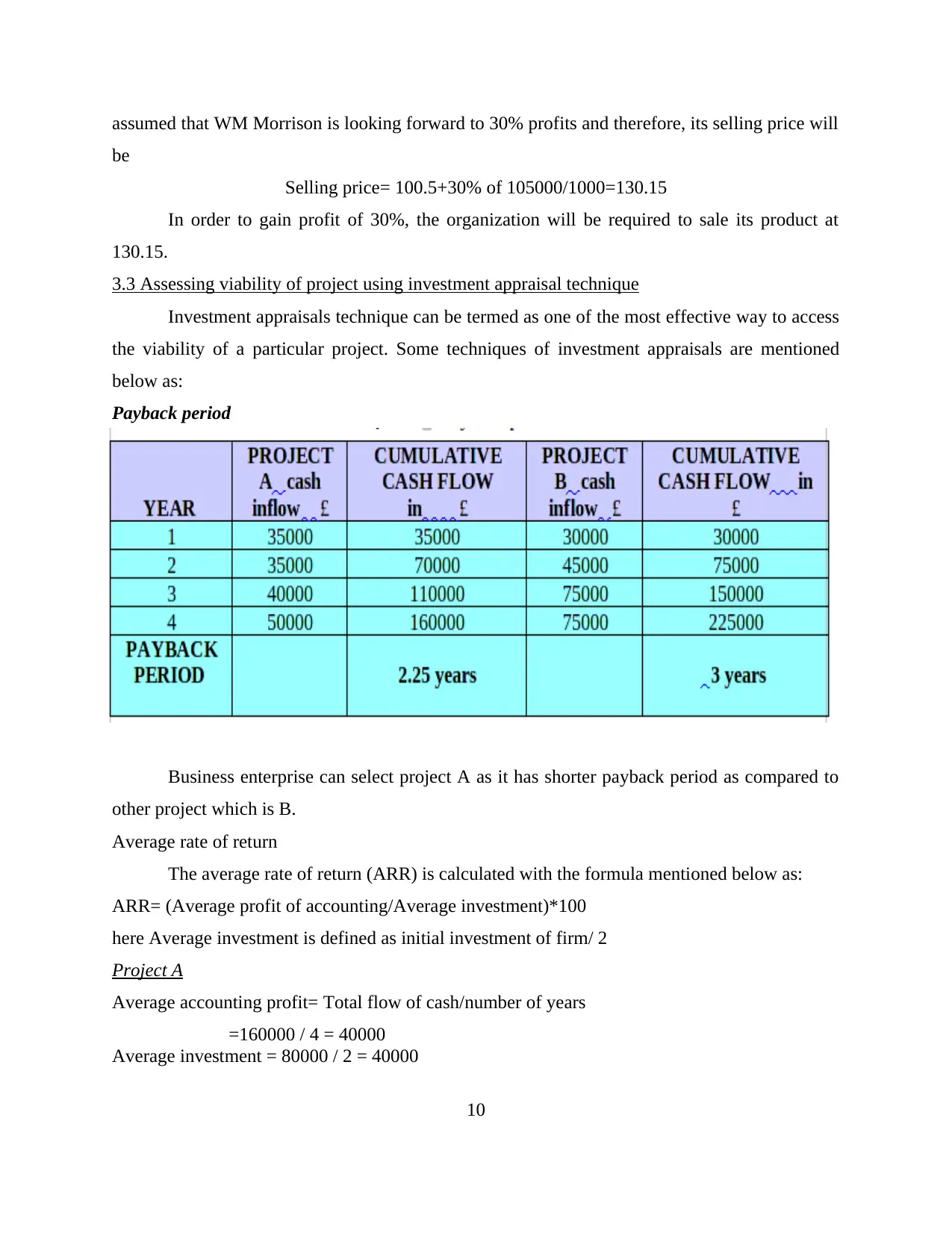
assumed that WM Morrison is looking forward to 30% profits and therefore, its selling price will
be
Selling price= 100.5+30% of 105000/1000=130.15
In order to gain profit of 30%, the organization will be required to sale its product at
130.15.
3.3 Assessing viability of project using investment appraisal technique
Investment appraisals technique can be termed as one of the most effective way to access
the viability of a particular project. Some techniques of investment appraisals are mentioned
below as:
Payback period
Business enterprise can select project A as it has shorter payback period as compared to
other project which is B.
Average rate of return
The average rate of return (ARR) is calculated with the formula mentioned below as:
ARR= (Average profit of accounting/Average investment)*100
here Average investment is defined as initial investment of firm/ 2
Project A
Average accounting profit= Total flow of cash/number of years
=160000 / 4 = 40000
Average investment = 80000 / 2 = 40000
10
be
Selling price= 100.5+30% of 105000/1000=130.15
In order to gain profit of 30%, the organization will be required to sale its product at
130.15.
3.3 Assessing viability of project using investment appraisal technique
Investment appraisals technique can be termed as one of the most effective way to access
the viability of a particular project. Some techniques of investment appraisals are mentioned
below as:
Payback period
Business enterprise can select project A as it has shorter payback period as compared to
other project which is B.
Average rate of return
The average rate of return (ARR) is calculated with the formula mentioned below as:
ARR= (Average profit of accounting/Average investment)*100
here Average investment is defined as initial investment of firm/ 2
Project A
Average accounting profit= Total flow of cash/number of years
=160000 / 4 = 40000
Average investment = 80000 / 2 = 40000
10
Paraphrase This Document
Need a fresh take? Get an instant paraphrase of this document with our AI Paraphraser
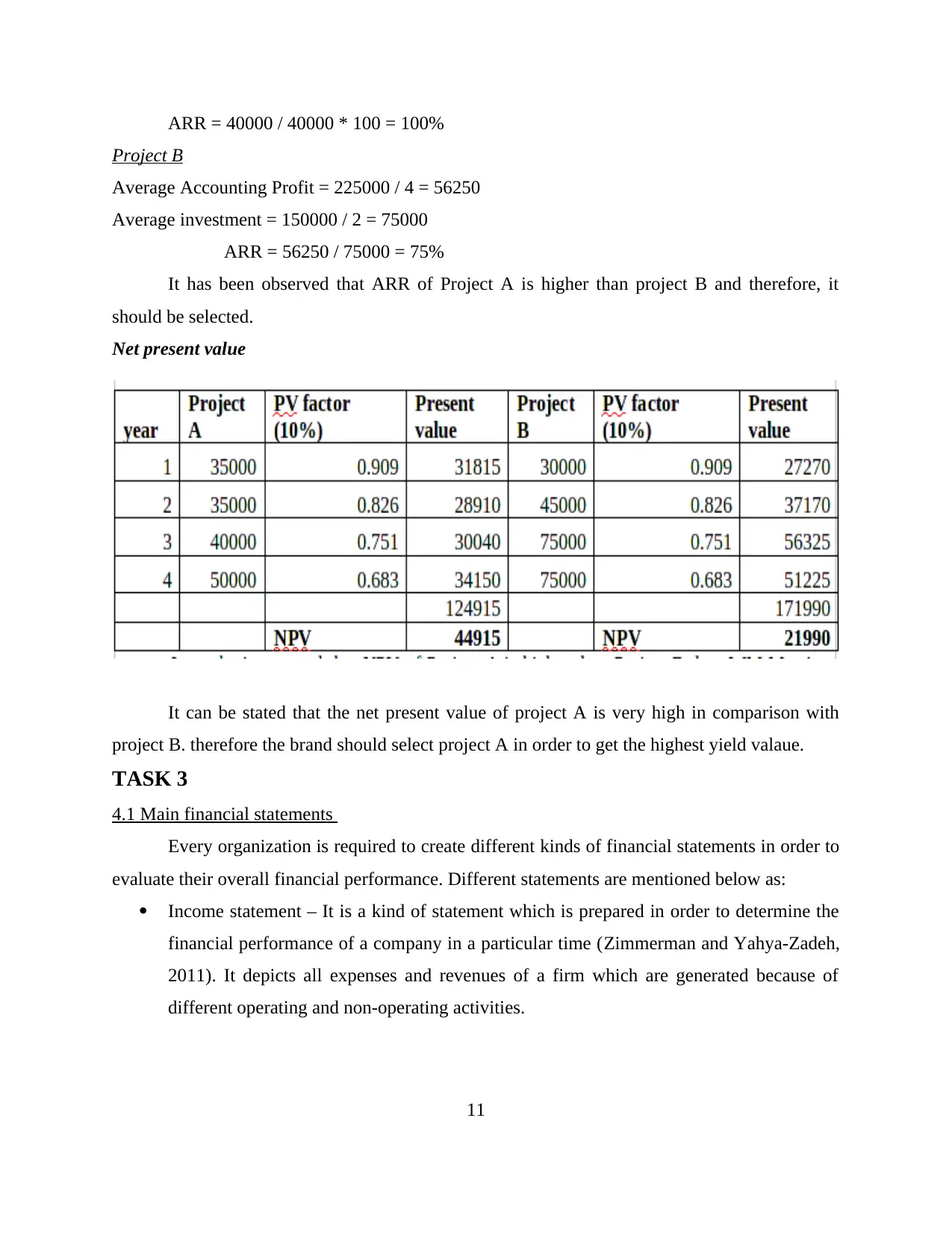
ARR = 40000 / 40000 * 100 = 100%
Project B
Average Accounting Profit = 225000 / 4 = 56250
Average investment = 150000 / 2 = 75000
ARR = 56250 / 75000 = 75%
It has been observed that ARR of Project A is higher than project B and therefore, it
should be selected.
Net present value
It can be stated that the net present value of project A is very high in comparison with
project B. therefore the brand should select project A in order to get the highest yield valaue.
TASK 3
4.1 Main financial statements
Every organization is required to create different kinds of financial statements in order to
evaluate their overall financial performance. Different statements are mentioned below as:
Income statement – It is a kind of statement which is prepared in order to determine the
financial performance of a company in a particular time (Zimmerman and Yahya-Zadeh,
2011). It depicts all expenses and revenues of a firm which are generated because of
different operating and non-operating activities.
11
Project B
Average Accounting Profit = 225000 / 4 = 56250
Average investment = 150000 / 2 = 75000
ARR = 56250 / 75000 = 75%
It has been observed that ARR of Project A is higher than project B and therefore, it
should be selected.
Net present value
It can be stated that the net present value of project A is very high in comparison with
project B. therefore the brand should select project A in order to get the highest yield valaue.
TASK 3
4.1 Main financial statements
Every organization is required to create different kinds of financial statements in order to
evaluate their overall financial performance. Different statements are mentioned below as:
Income statement – It is a kind of statement which is prepared in order to determine the
financial performance of a company in a particular time (Zimmerman and Yahya-Zadeh,
2011). It depicts all expenses and revenues of a firm which are generated because of
different operating and non-operating activities.
11
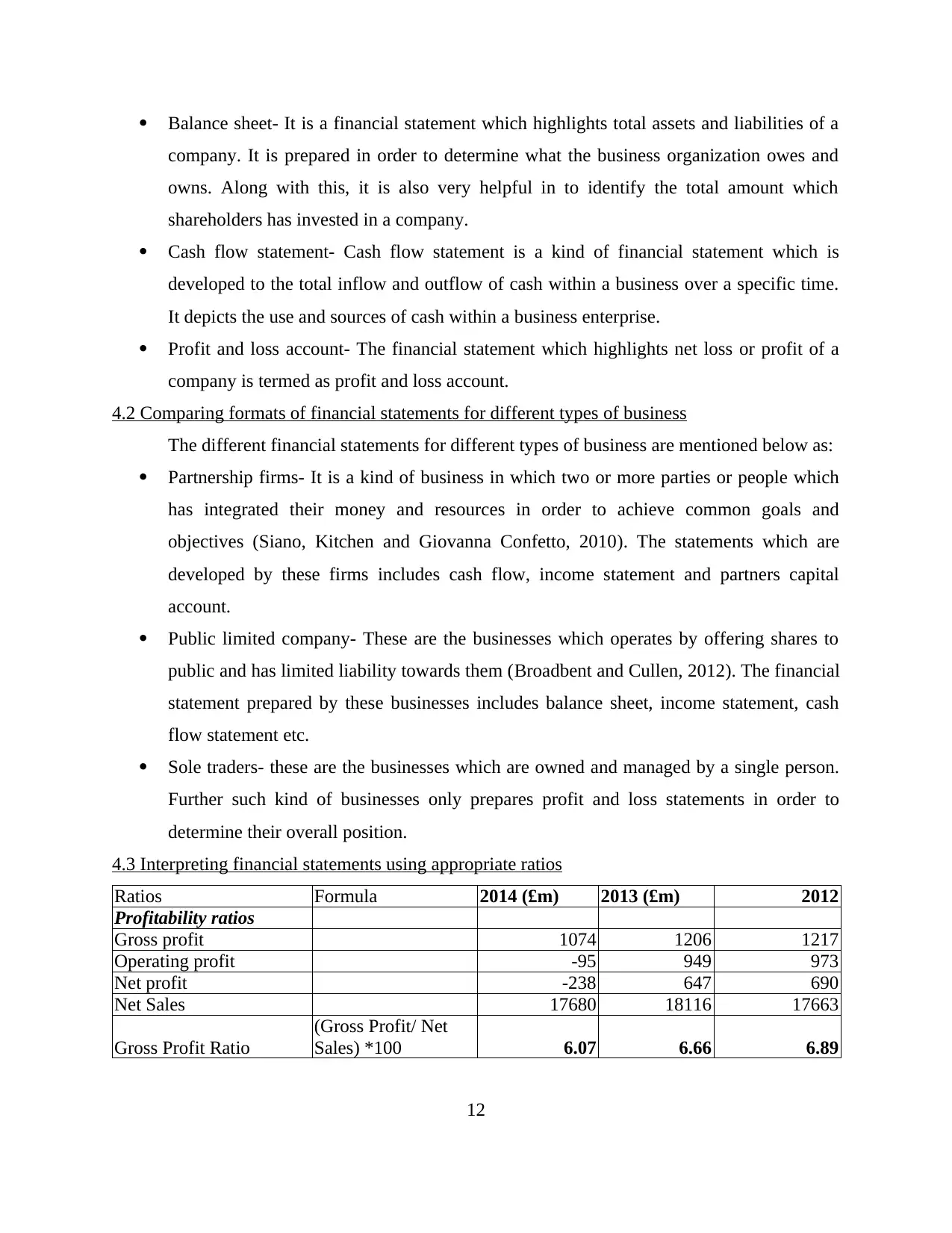
Balance sheet- It is a financial statement which highlights total assets and liabilities of a
company. It is prepared in order to determine what the business organization owes and
owns. Along with this, it is also very helpful in to identify the total amount which
shareholders has invested in a company.
Cash flow statement- Cash flow statement is a kind of financial statement which is
developed to the total inflow and outflow of cash within a business over a specific time.
It depicts the use and sources of cash within a business enterprise.
Profit and loss account- The financial statement which highlights net loss or profit of a
company is termed as profit and loss account.
4.2 Comparing formats of financial statements for different types of business
The different financial statements for different types of business are mentioned below as:
Partnership firms- It is a kind of business in which two or more parties or people which
has integrated their money and resources in order to achieve common goals and
objectives (Siano, Kitchen and Giovanna Confetto, 2010). The statements which are
developed by these firms includes cash flow, income statement and partners capital
account.
Public limited company- These are the businesses which operates by offering shares to
public and has limited liability towards them (Broadbent and Cullen, 2012). The financial
statement prepared by these businesses includes balance sheet, income statement, cash
flow statement etc.
Sole traders- these are the businesses which are owned and managed by a single person.
Further such kind of businesses only prepares profit and loss statements in order to
determine their overall position.
4.3 Interpreting financial statements using appropriate ratios
Ratios Formula 2014 (£m) 2013 (£m) 2012
Profitability ratios
Gross profit 1074 1206 1217
Operating profit -95 949 973
Net profit -238 647 690
Net Sales 17680 18116 17663
Gross Profit Ratio
(Gross Profit/ Net
Sales) *100 6.07 6.66 6.89
12
company. It is prepared in order to determine what the business organization owes and
owns. Along with this, it is also very helpful in to identify the total amount which
shareholders has invested in a company.
Cash flow statement- Cash flow statement is a kind of financial statement which is
developed to the total inflow and outflow of cash within a business over a specific time.
It depicts the use and sources of cash within a business enterprise.
Profit and loss account- The financial statement which highlights net loss or profit of a
company is termed as profit and loss account.
4.2 Comparing formats of financial statements for different types of business
The different financial statements for different types of business are mentioned below as:
Partnership firms- It is a kind of business in which two or more parties or people which
has integrated their money and resources in order to achieve common goals and
objectives (Siano, Kitchen and Giovanna Confetto, 2010). The statements which are
developed by these firms includes cash flow, income statement and partners capital
account.
Public limited company- These are the businesses which operates by offering shares to
public and has limited liability towards them (Broadbent and Cullen, 2012). The financial
statement prepared by these businesses includes balance sheet, income statement, cash
flow statement etc.
Sole traders- these are the businesses which are owned and managed by a single person.
Further such kind of businesses only prepares profit and loss statements in order to
determine their overall position.
4.3 Interpreting financial statements using appropriate ratios
Ratios Formula 2014 (£m) 2013 (£m) 2012
Profitability ratios
Gross profit 1074 1206 1217
Operating profit -95 949 973
Net profit -238 647 690
Net Sales 17680 18116 17663
Gross Profit Ratio
(Gross Profit/ Net
Sales) *100 6.07 6.66 6.89
12
⊘ This is a preview!⊘
Do you want full access?
Subscribe today to unlock all pages.

Trusted by 1+ million students worldwide
1 out of 14
Related Documents
Your All-in-One AI-Powered Toolkit for Academic Success.
+13062052269
info@desklib.com
Available 24*7 on WhatsApp / Email
![[object Object]](/_next/static/media/star-bottom.7253800d.svg)
Unlock your academic potential
Copyright © 2020–2025 A2Z Services. All Rights Reserved. Developed and managed by ZUCOL.





